This article is basically for the ones who are about to get their hands on Hybrid mobile application development. Side note: even though Apache Cordova has entered the market, I would talk about Cordova only.
This post guides you about the Cordova base, Concepts, and files that need to be cleared before starting the codes and how it can make give ease to learn Apache Cordova comfortably.
Mobile apps are no longer seen as an additional investment. Rather, they are considered a necessity. Mobile is the best way to cater to the requirements of the customers, the successful line of a company is often reliant on the fact that how effectively it utilizes the current trends on board.
Jump to Section
A Great Toolbox for Cross-Platform Apps
A second major concept of Apache Cordova, Apache Cordova is a famous development framework found to give the coder the toolbox needed for building cross-platform web-based apps optimized for desktop active, mobile. It features a structure-rich templating approach, easy-to-write and readable syntax.
While mobile applications in large-scale companies are used for firsthand campaigning, branding, and shooting up customer engagement, in small-scale ventures. They are used for bringing their own apps into being. So, if you are searching for some new mobile development trends to create an exemplary before your competitors, you have come to the right page then!
Mobile applications arrive in a couple of flavors:
- Native,
- Mobile web (HTML5 application),
- Hybrid.
However, each sort has its points of interest and inconveniences, both at the same time. The issues emerge when you pick one write without thinking about your needs and your target audience.
Innovation Drives the Market
Innovation or technology today influences each part of the market, making them dynamic, progressive, and productive, and contributing outside the reach of technology is someplace somewhat troublesome. However, not all are persuaded that the tech sector is the best place to invest, perhaps on account of the consistent risk versus gain factor.
With mobile applications introduced for mobile operating systems from Apple, Android, and others, you can make brand loyalty and awareness amongst a tremendous number of existing and potential clients.
Truth be told, numerous clients now expect a business or brand to have its own committed mobile application. This implies it isn’t just turning into a need to pick up a competitive edge over different organizations. It is turning into a need to abstain from falling behind your opposition. Having a devoted mobile application adds to the credibility of the brand.
Mobile App Development Is a Growing Trend
Moving ahead, if we talk about business, the trend of mobile app development is ruling over the mobile industry. In order to gain an edge over your competitors, customer loyalty, and more interactions with your users, it is vital for your business to join the league of mobile apps developer example, many accept that a native mobile application conveys the best mobile experience.
Now and again, that is valid. In different cases, the native approach for mobile app development may, however, prove as the worst choice. As opposed to simply go the native application development, think about your target audience, when and for what reason do they utilize the application, and what are they attempting to achieve with the use of your designed app. At exactly that point, you will know which development process to chose from the variety.
What Is Apache Cordova?
Apache Cordova allows for building native mobile applications using HTML, CSS, and JavaScript. It is a hybrid mobile applications platform using JavaScript HTML and CSS. Cordova is an open-source mobile development framework that is used to develop the hybrid app. This tool helps with the management of multi-platform Cordova applications.
It helps you to develop and include standard web technologies such as JavaScript, CSS3, and HTML5 for cross-platform mobile application development, avoiding each mobile platform’s native mobile application development language.
Apache Cordova binds your JavaScript/HTML app into a container called native container which can access the device functions of several platforms. It allowing you to easily write one set of code to target nearly every phone or tablet on the market today and publish to their app stores.
All mobile developers used Apache Cordova to mix native application components with a WebView. It can access all device-level API, or if you want to develop a plugin interface between native and WebView components.
The Architecture of Apache Cordova
There are several level hierarchy architectures in a Cordova application.
We can understand the architecture of the Cordova application with the below image:
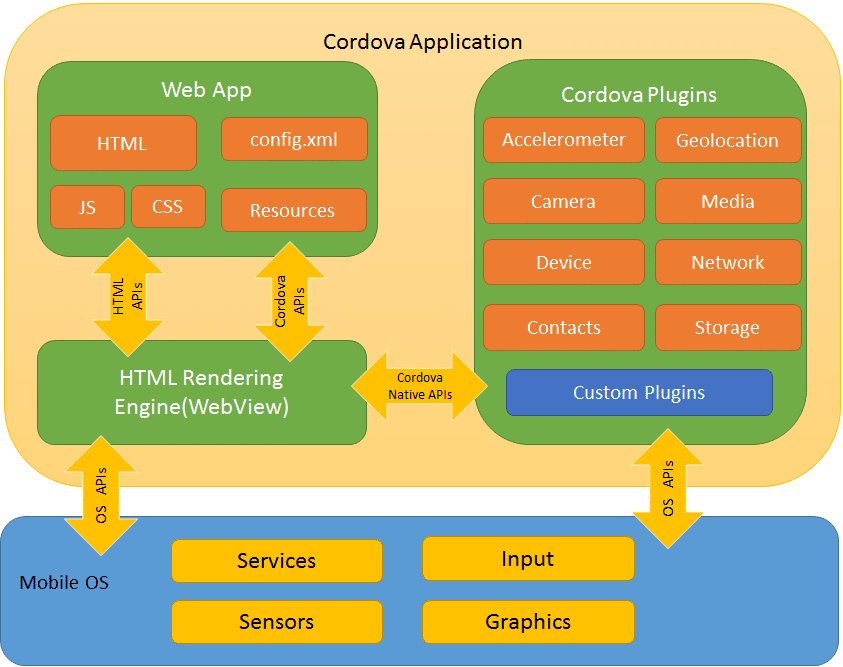
The Cordova WebView
- The Apache Cordova-enabled WebView may provide the application with its entire user interface.
- A WebView is a part of the Android operating system. It’s responsible for rendering web pages in most Android applications. Whenever you see web content in an Android application, chances are you’re looking at a WebView in that application. The exception to this rule is Google Chrome for Android devices. Chrome uses its own rendering engine built into the application (The same goes for some third-party Android browsers like Firefox, InternetExplorer, etc.)
- In previous versions of Android (4.3 or below), WebView uses code based on Apple’s Webkit — the same technology behind the Safari browser.
Cordova Plugins
- A plugin is a piece of software containing a group of functions that can be added to a Cordova application. They help to extend the functionality of your application and also add new features to your Cordova application. Basically, plugins are an integral part of Cordova. These plugins provide a channel for Cordova components and native components to communicate with each other and bindings to standard device APIs. This will enable you to invoke native code from JavaScript.
- There are different plugins that are available which provide additional binding to features not necessarily available on all platforms. You can also search for Cordova plugins on npm (node package manager).

Paths
Apache Cordova provides basically two workflows methods to create a mobile application. While you can often use either workflow method to implements the same task, they each offer different advantages
- Cross-platform (CLI) workflow Method: Apply this method which helps your application to run on different mobile operating systems such as iOS, Android, etc as possible, with less need for platform-specific development. This workflow centralized around the Cordova CLI.
It is a tool to build an application for many platforms at once, abstracting away much of the functionality of lower-level shell scripts. The cross-platform (CLI) contain web directories into subdirectories for different mobile operating system platform. CLI also provides a common interface that helps to apply plugins to your app. To get started, follow all steps in the Create your first app guide. Otherwise, you have a need for a platform-centered workflow, even though the cross-platform workflow is recommended. - Platform-centered workflow Method: Apply this workflow method which helps to focus on building an app for a single platform and need to be able to modify it at a lower level of complexity. You can use this approach to mix native components with web-based Cordova components.
Installing Cordova
The installation of Apache Cordova will differ depending on the workflow method above you choose:
- Cross-platform workflow.
- Platform-centered workflow.
Create your first Cordova Hybrid application
Here, you get to know how to create an HTML/JS Apache Cordova application and deploy them on various native mobile platforms like iOS and Android using the Cordova command-line interface (CLI).
Installing the Apache Cordova CLI into your machine.
To install the Apache Cordova command-line tool, follow these steps:
- Download and install Node.js into your system. On installation, you should be able to call node and on npm your command line.
- Download and install a git repository into your system.
- After that, install the Apache Cordova module using the npm (node package manager) utility of Node.js. The Cordova module will automatically be downloaded by the npm (node package utility).
Linux operating system users, follow these steps:-
$ sudo npm install -g cordova
For Linux, adding the npm command before sudo may be necessary to install the npm module.
For Windows operating system follow these steps:-
C:\>npm install -g cordova
The -g tells npm to install apache Cordova globally.
Android SDK
- For the Android platform, you need to have Android SDK installed on your system.
- You can download the Android SDK tool from this link.
https://developer.android.com/studio/index.html
After installing the Android SDK tool, follow these steps to create your first Android Hybrid App using Apache Cordova.
Then after installing Android SDK and JDK(java development kit), move to the directory where you maintain your source code, and create a Cordova project.
- $ cordova create hello world com.example.hello HelloWorld.
This will create the required directory structure for your Cordova application.
Adding a Platform
All commands need to be run within the project’s directory.
- $ cd hello
- $ cordova platform add ios or android
- $ cordova platform ls
Testing the App
Run the following command to start the application.
$ cordova emulate android
After this command, you will see the following screen as shown in the figure.
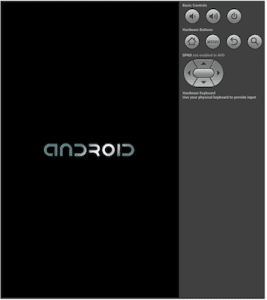
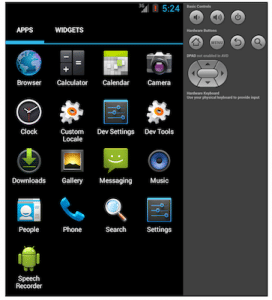
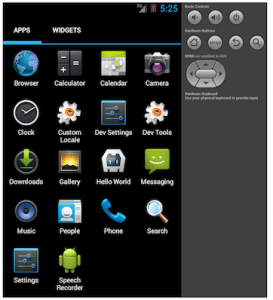
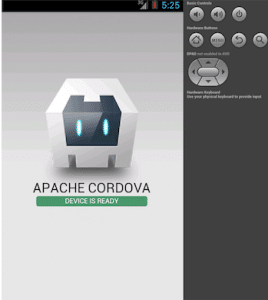
$ Cordova run android
While running this command, you need to set up the device for testing.
Advantages of Using Hybrid Apps
- Reduced Development Costs:- The hybrid mobile app is relatively cheaper as compared to a native app.
- Improved UI (User Interface):- Users expect the app to be instantly responsive to different devices and deliver a glitch-free experience. Hybrid apps are based on the idea of “information is just a tap away”.
- As you are most likely are aware of the fact that techniques and traditional methods of software development are generally time-consuming, hence it becomes quite obvious that it approximately takes six months to launch a new app to the Mobile app store.
- You can, however, multiply this figure by the number of apps required for a business and an application procedure turns into a non-starter even before it is formulated. However, numerous new and inventive strategies like quick application improvement and highlight driven advancement have empowered vigorous application advancement and arrangement, expelling the regular myth of a long time taking app development process.
- Feature-driven development is an iterative strategy for application advancement. It is primarily expected to serve deal with a task in light of object-oriented innovation. This is an exceptionally functional technique that deals with changing complexities.
- Maintenance of code: – A hybrid app is designed to make use of all the features available on the mobile device. The native apps also utilize all the device features, maintaining it is quite a challenge for users and developers alike.
- Hybrid mobile apps store the device’s API to save offline data.
- If we talk about business, the trend of mobile app development is ruling over the mobile industry. In order to gain an edge over your competitors, customer loyalty, and more interactions with your users, it is vital for your business to join the league of mobile apps developer example, many accept that a native mobile application conveys the best mobile experience.
Summary
In this blog, you can see how we can develop a mobile application with Apache Cordova technology. This technology helps in building cross-platform web-based apps optimized for desktop active, mobile.
- LinkedIn Scraper | LinkedIn Data Extractor Software Tool - February 22, 2021
- Is Web Scraping Legal? - February 15, 2021
- What Is Data Scraping? - February 10, 2021

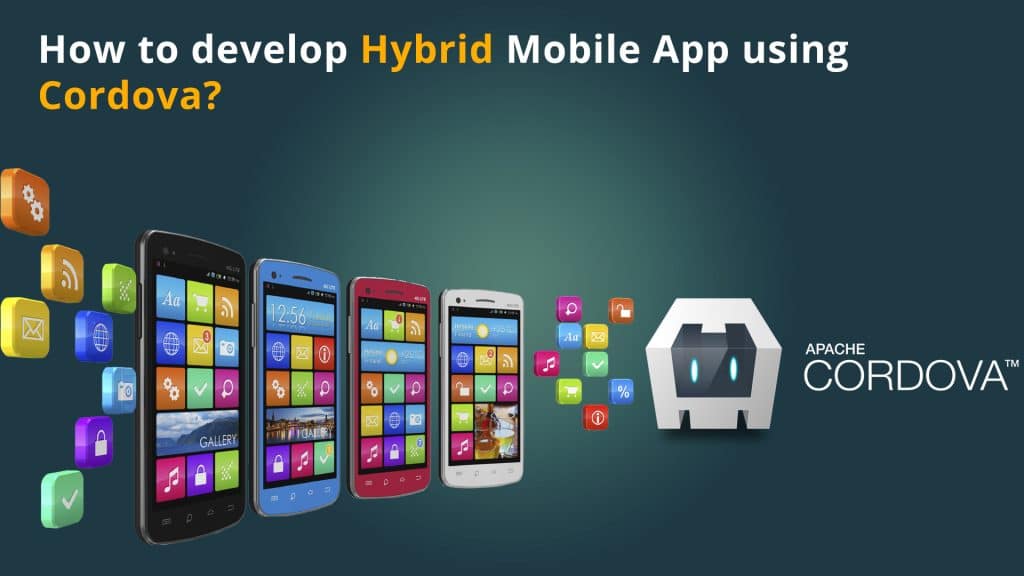
knowledgeable
good explanation
please briefly describe
Sure
Like!! Really appreciate you sharing this blog post.Really thank you! Keep writing.